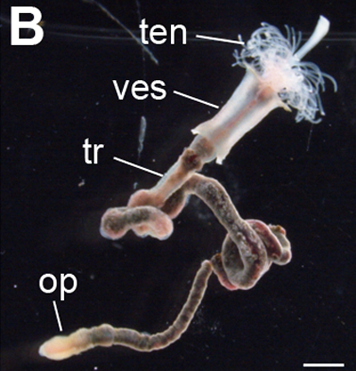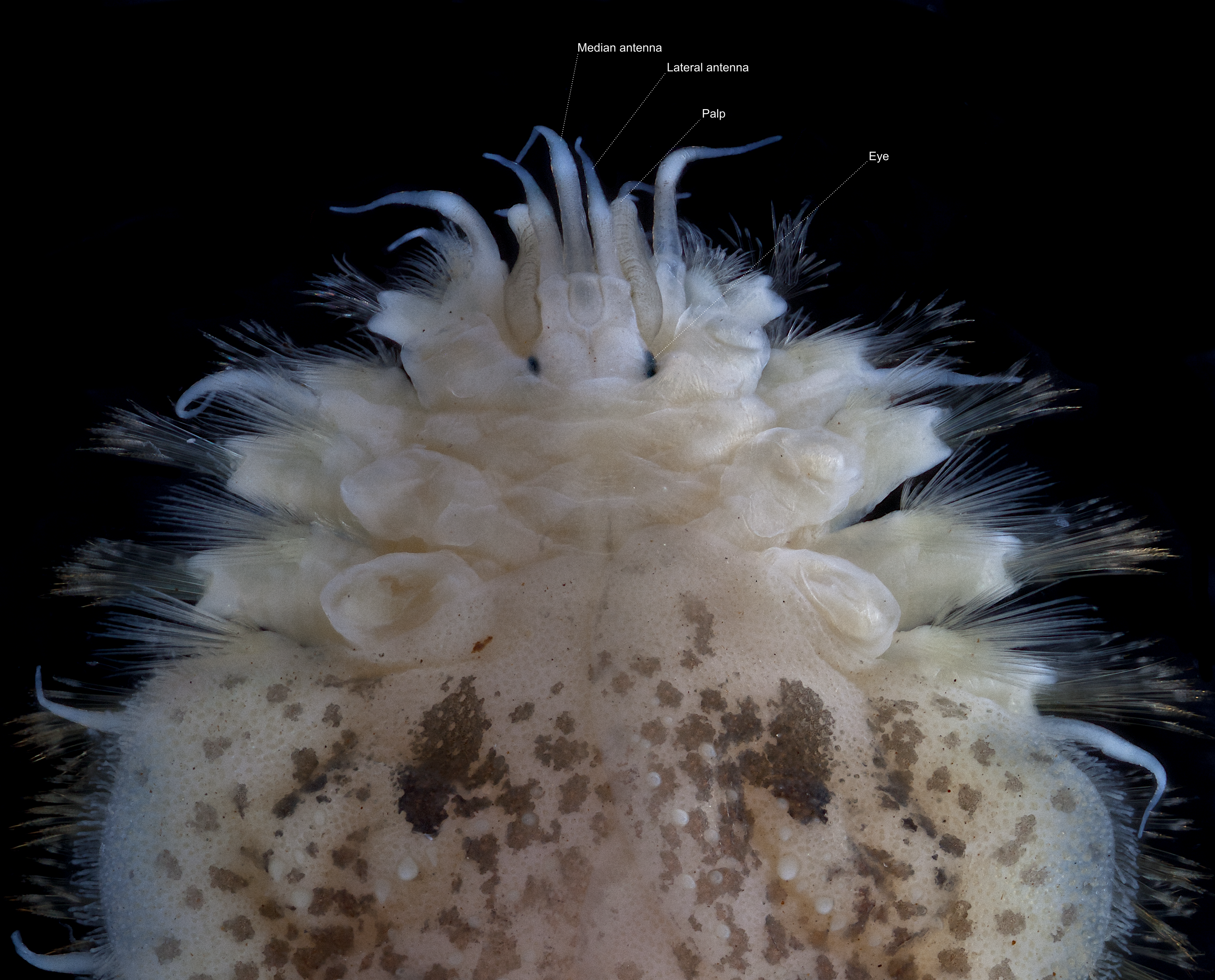|
Fan Worm
Sabellida is an order of annelid worms in the class Polychaeta. They are filter feeders with no buccal organ. The prostomium is fused with the peristomium and bears a ring of feathery feeding tentacles. They live in parchment-like tubes made of particles from their environment such as sand and shell fragments cemented together with mucus. Members of the suborder include the s (Sabellidae) and serpulid worms (Serpulidae). Among the species are the giant feather duster worm ('' |
Bispira
''Bispira'' is a genus of marine bristleworm Polychaeta () is a paraphyletic class of generally marine annelid worms, commonly called bristle worms or polychaetes (). Each body segment has a pair of fleshy protrusions called parapodia that bear many bristles, called chaetae, which are ma ... in the family Sabellidae. Its members were initially included in genus ''Sabella'' by Grube in 1851. In 1856, Krøyer described ''Bispira'' as a separate genus. Members of ''Bispira'' are defined by spirally-coiled, equally-divided branchial lobes. Species According to the World Register of Marine Species, ''Bispira'' contains 31 valid species: * '' Bispira brunnea'' (Treadwell, 1917) * '' Bispira crassicornis'' (Sars, 1851) * '' Bispira elegans'' (Bush, 1905) * '' Bispira fabricii'' (Krøyer, 1856) * '' Bispira guinensis'' (Augener, 1918) * '' Bispira klautae'' Costa-Paiva & Paiva, 2007 * '' Bispira manicata'' (Grube, 1878) * '' Bispira mariae'' Lo Bianco, 1893 * '' Bispira ... [...More Info...] [...Related Items...] OR: [Wikipedia] [Google] [Baidu] |
Oweniidae
Oweniidae is a family of marine polychaete worms in the suborder Sabellida. The worms live in tubes made of sand and are selective filter feeders, detritivores and grazers. Characteristics Members of this family live in tubes made of sand and shell fragments. The head of the worm does not bear a proboscis, but has the mouth at the tip rimmed by some very short tentacles. The body segments lack parapodia In invertebrates, the term parapodium ( Gr. ''para'', beyond or beside + ''podia'', feet; plural: parapodia) refers to lateral outgrowths or protrusions from the body. Parapodia are predominantly found in annelids, where they are paired, unjointed ... and are smooth elongated cylinders. There are a large number of hooked chaetae or bristles on a small pad on the ventral side of each segment. These chaetae have two parallel teeth resembling claws which is a feature that distinguishes members of this family from other polychaetes. The posterior tip bears different appendages in dif ... [...More Info...] [...Related Items...] OR: [Wikipedia] [Google] [Baidu] |
Sabellariidae
Sabellariidae is a family of marine polychaete worms in the suborder Sabellida. The worms live in tubes made of sand and are filter feeders and detritivores. Characteristics Members of this family live in tubes made of sand and shell fragments cemented together and attached to rocks. Some species are colonial and the multitude of their tubes may create hummocks and even reefs. The top of the tube can be closed by an operculum formed by several rings of bristles on the head of the worm. The head also bears several fine feeding tentacle In zoology, a tentacle is a flexible, mobile, and elongated organ present in some species of animals, most of them invertebrates. In animal anatomy, tentacles usually occur in one or more pairs. Anatomically, the tentacles of animals work main ...s and a pair of small palps. The thoracic section of the body has 3 or 4 segments with paddle-like capillary bristles. The abdominal section has many segments each with hooked bristles on raised lobes ... [...More Info...] [...Related Items...] OR: [Wikipedia] [Google] [Baidu] |
Sabellidae
Sabellidae, or feather duster worms, are a family of marine polychaete tube worms characterized by protruding feathery branchiae. Sabellids build tubes out of a tough, parchment-like exudate, strengthened with sand and bits of shell. Unlike the other sabellids, the genus '' Glomerula'' secretes a tube of calcium carbonate instead. Sabellidae can be found in subtidal habitats around the world. Their oldest fossils are known from the Early Jurassic. Characteristics Feather-duster worms have a crown of feeding appendages or radioles in two fan-shaped clusters projecting from their tubes when under water. Each radiole has paired side branches making a two-edged comb for filter feeding. Most species have a narrow collar below the head. The body segments are smooth and lack parapodia. The usually eight thoracic segments bear capillaries dorsally and hooked chaetae (bristles) ventrally. The abdominal segments are similar, but with the position of the capillaries and chaetae reversed. T ... [...More Info...] [...Related Items...] OR: [Wikipedia] [Google] [Baidu] |
Serpulidae
The Serpulidae are a family of sessile, tube-building annelid worms in the class Polychaeta. The members of this family differ from other sabellid tube worms in that they have a specialized operculum that blocks the entrance of their tubes when they withdraw into the tubes. In addition, serpulids secrete tubes of calcium carbonate. Serpulids are the most important biomineralizers among annelids. About 300 species in the family Serpulidae are known, all but one of which live in saline waters. The earliest serpulids are known from the Permian ( Wordian to late Permian). The blood of most species of serpulid and sabellid worms contains the oxygen-binding pigment chlorocruorin. This is used to transport oxygen to the tissues. It has an affinity for carbon monoxide which is 570 times as strong as that of the haemoglobin found in human blood. Empty serpulid shells can sometimes be confused with the shells of a family of marine gastropod mollusks, the Vermetidae or worm snails. ... [...More Info...] [...Related Items...] OR: [Wikipedia] [Google] [Baidu] |
Siboglinidae
Siboglinidae is a family of polychaete annelid worms whose members made up the former phyla Pogonophora and Vestimentifera (the giant tube worms). The family is composed of about 100 species of vermiform creatures which live in thin tubes buried in sediments (Pogonophora) or in tubes attached to hard substratum (Vestimentifera) at ocean depths ranging from . They can also be found in association with hydrothermal vents, methane seeps, sunken plant material, and whale carcasses. The first specimen was dredged from the waters of what is now Indonesia in 1900. These specimens were given to French zoologist Maurice Caullery, who studied them for nearly 50 years. Anatomy Most siboglinids are less than in diameter, but in length. They inhabit tubular structures composed of chitin and fixed to rocks or substrate. The tubes are often clustered together in large colonies. Their bodies are divided into four regions. The anterior end is called the cephalic lobe, which bears from one t ... [...More Info...] [...Related Items...] OR: [Wikipedia] [Google] [Baidu] |
Order (biology)
Order ( la, ordo) is one of the eight major hierarchical taxonomic ranks in Linnaean taxonomy. It is classified between family and class. In biological classification, the order is a taxonomic rank used in the classification of organisms and recognized by the nomenclature codes. An immediately higher rank, superorder, is sometimes added directly above order, with suborder directly beneath order. An order can also be defined as a group of related families. What does and does not belong to each order is determined by a taxonomist, as is whether a particular order should be recognized at all. Often there is no exact agreement, with different taxonomists each taking a different position. There are no hard rules that a taxonomist needs to follow in describing or recognizing an order. Some taxa are accepted almost universally, while others are recognized only rarely. The name of an order is usually written with a capital letter. For some groups of organisms, their orders may fol ... [...More Info...] [...Related Items...] OR: [Wikipedia] [Google] [Baidu] |
Annelid
The annelids (Annelida , from Latin ', "little ring"), also known as the segmented worms, are a large phylum, with over 22,000 extant species including ragworms, earthworms, and leeches. The species exist in and have adapted to various ecologies – some in marine environments as distinct as tidal zones and hydrothermal vents, others in fresh water, and yet others in moist terrestrial environments. The Annelids are bilaterally symmetrical, triploblastic, coelomate, invertebrate organisms. They also have parapodia for locomotion. Most textbooks still use the traditional division into polychaetes (almost all marine), oligochaetes (which include earthworms) and leech-like species. Cladistic research since 1997 has radically changed this scheme, viewing leeches as a sub-group of oligochaetes and oligochaetes as a sub-group of polychaetes. In addition, the Pogonophora, Echiura and Sipuncula, previously regarded as separate phyla, are now regarded as sub-groups of polychae ... [...More Info...] [...Related Items...] OR: [Wikipedia] [Google] [Baidu] |
Polychaeta
Polychaeta () is a paraphyletic class of generally marine annelid worms, commonly called bristle worms or polychaetes (). Each body segment has a pair of fleshy protrusions called parapodia that bear many bristles, called chaetae, which are made of chitin. More than 10,000 species are described in this class. Common representatives include the lugworm (''Arenicola marina'') and the sandworm or clam worm ''Alitta''. Polychaetes as a class are robust and widespread, with species that live in the coldest ocean temperatures of the abyssal plain, to forms which tolerate the extremely high temperatures near hydrothermal vents. Polychaetes occur throughout the Earth's oceans at all depths, from forms that live as plankton near the surface, to a 2- to 3-cm specimen (still unclassified) observed by the robot ocean probe ''Nereus'' at the bottom of the Challenger Deep, the deepest known spot in the Earth's oceans. Only 168 species (less than 2% of all polychaetes) are known fro ... [...More Info...] [...Related Items...] OR: [Wikipedia] [Google] [Baidu] |
Prostomium
The prostomium (From Ancient Greek, meaning "before the mouth"; plural: prostomia; sometimes also called the "acron") is the cephalized first body segment in an annelid worm's body at the anterior end. It is in front of (but does not include) the mouth, being usually a small shelf- or lip-like extension over the dorsal side of the mouth. The prostomium together with the peristomium, which includes the mouth and pharynx, make up the annelid head. Description The prostomium is part of the head and holds at least part of the brain and often bears sensory structures such as the eyes, antennae and palps. It may function like a kind of overlip when the animal is feeding. The prostomium bears many important taxonomic characters and its shape and composition are important for annelid systematics. In addition to the eyes, antennae and palps, the prostomium can possess appendages such as tentacles or cirri. Moreover, some polychaete prostomia have a posterior extension or ridge wit ... [...More Info...] [...Related Items...] OR: [Wikipedia] [Google] [Baidu] |
Feather Duster Worm
Sabellidae, or feather duster worms, are a family of marine polychaete tube worms characterized by protruding feathery branchiae. Sabellids build tubes out of a tough, parchment-like exudate, strengthened with sand and bits of shell. Unlike the other sabellids, the genus '' Glomerula'' secretes a tube of calcium carbonate instead. Sabellidae can be found in subtidal habitats around the world. Their oldest fossils are known from the Early Jurassic. Characteristics Feather-duster worms have a crown of feeding appendages or radioles in two fan-shaped clusters projecting from their tubes when under water. Each radiole has paired side branches making a two-edged comb for filter feeding. Most species have a narrow collar below the head. The body segments are smooth and lack parapodia. The usually eight thoracic segments bear capillaries dorsally and hooked chaetae (bristles) ventrally. The abdominal segments are similar, but with the position of the capillaries and chaetae reversed. ... [...More Info...] [...Related Items...] OR: [Wikipedia] [Google] [Baidu] |



